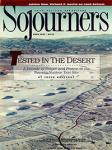For the past decade, conservative culture warriors have claimed that the only reason there is still any visible, or audible, dissent in America is because of the aging New Leftists and Carter-era appointees entrenched in the taxpayer-subsidized enclaves of public education, academia, and the official cultural institutions (i.e., the National Endowments, PBS, and the like). The Right has always claimed that it is patently unfair that taxpayers' money goes to subsidize the promulgation of views and values offensive to the American mainstream.
It's a neat theory. But, as usual, the Rightists are wrong. They're wrong about the sources of dissent, and wrong about the American mainstream.
As the Gulf war demonstrated yet again, there are two primary institutional homes for dissent in America, even during a popular war. And they are not in the academy or the officially subsidized cultural establishment. They are in two well-known clusters of voluntary associations, both privately funded by entrepreneurial means. And they are both squarely in the mainstream of Main Street American life.
As all readers of this magazine know, one of these base camps of dissent is found in the mainline Protestant denominations and large sectors of the Catholic Church. The other, as readers of this column should know by now, is in the popular arts -- most clearly in the pop-music world of rock and roll, hip-hop, etc., but also in prominent quarters of Hollywood. To really root out dissent in America, you'd have to stop the public from passing the plate and buying discs and tapes. Religious dissent on the Gulf war has been well-covered in these pages. So let's look now at what Paul Harvey would call "the rest of the story."
AS WAS TRUE for most everyone else, pop-artist dissenters made stronger, and better-focused, statements during the long prelude to the war than during the heat of battle. Most impressive was the reworking of "Give Peace a Chance," put together by Sean Ono Lennon and Lenny Kravitz, respectively the second son and most famous fan of the song's late composer. The record and video brought together a "We Are the World"-ish cast of dozens, which was heavy on the rappers but also reached back to honorable old New Leftists like Bonnie Raitt.
It was pretty cool, message- and music-wise. Without any updating, Lennon Sr.'s sonic minimalism of two decades past sounded right at home in the land of hip-hop. And the message fit the days of buildup and countdown even better than it did the time in which it was first written.
It was cool. But it didn't work. And when no one blinked and the bombs began to fall, a simple and unambiguous message became more difficult to formulate, at least if you had any hopes of being understood. The public mood, this time around, was more concerned with national unity than moral distinctions. At least that's how I choose to explain the sudden turnaround on Gulf policy pulled by about 40 percent of the opinion-polled population. That is an eminently understandable, and even justifiable, sentiment. I'll admit that even I found the sense of national solidarity surrounding the troops and their families impressive.
I'd contend that such a show of communal empathy is, in and of itself, a good thing. It is a good thing most often exploited toward destructive ends, but still it is a good thing. To this dissenting mind, it's not a helpful strategy to promote the greater good of "peace" by tearing down another good called "solidarity." Given these ambiguities, by the time I got around to formulating my own public stance toward, and against, the war, the war was almost over. That's one of the problems with ambiguities.
However, there was at least one wartime expression of dissent in the pop arena that I thought captured all of those nuances and still packed an emotional wallop. The Rolling Stones single "Highwire" came close with its pointed denunciation of Western arms sales to Iraq and poignant hope that the troops would escape a desert filled with "hot lead and cold, cold nights." The Stones' statement was strong enough to earn widespread condemnation in the British House of Parliament. But the three-minute single was probably too confining a vehicle to do justice to the moment.
It was, surprisingly, that old rock eccentric Neil Young who did the moment justice -- and rock tradition proud -- on his Ragged Glory concert tour with Crazy Horse (promoting the masterpiece album of the same name). On last year's Freedom tour, which featured the anti-Bush anthem "Rocking in the Free World," Young used a giant peace symbol as the backdrop behind the concert stage. When he hit the road in January, in the midst of war fever, Young pointedly chose to use the peace symbol again. But he added to the stage set a long, flowing "support-the-troops" yellow ribbon tied around a 20-foot-high fake microphone stand.
At the beginning of the show, while the peace sign lit up and the ribbon was unfurled, the house sound system played Jimi Hendrix's version of "The Star-Spangled Banner." Then, about three songs into the set, with yellow ribbon blowing all around him, Young performed a painfully slow, feedback-drenched, solo electric guitar and voice rendition of Bob Dylan's "Blowing in the Wind."
And yes, even down here in the Deepest South, in the state with the highest per capita ratio of troops in the field, the loudest cheers came for the line, "How many times will the cannonballs fly, before they're forever banned?" And that just about says it all.
Danny Duncan Collum is a contributing editor of Sojourners.

Got something to say about what you're reading? We value your feedback!